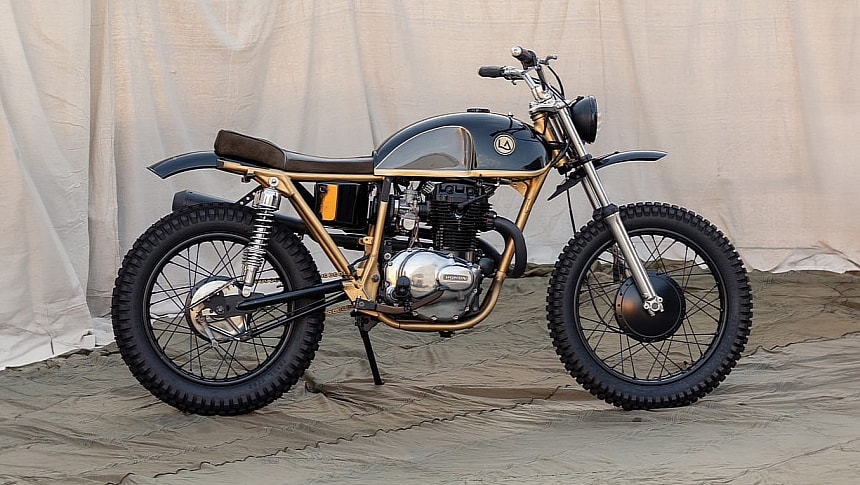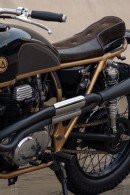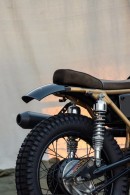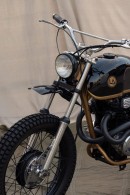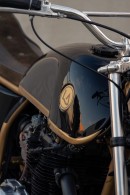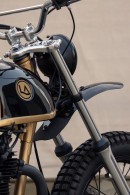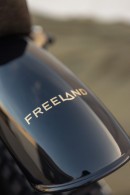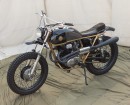It’s always nice to see a custom motorcycle that goes far beyond the usual mods we normally talk about here. Whereas most projects will take their core components from the same bike, some builders are determined to mix things up in different ways. A great example of this can be seen in the photo gallery below, hailing from Freeland Motorcycles over in Burbank, California.
Freeland is the brainchild of Ronnie Hansen, who’d experienced a bit of a rough start when he founded his shop a few years ago. Maintenance, service, and repairs were part of the man’s regular schedule for the first three months, but the pandemic came along and forced him to change his business model in order to stay afloat. Seeing customization as the way to go, he made the switch and hasn’t looked back ever since.
Ronnie focuses on British and more so Japanese classics, with the latter being our point of interest for today. The stylish scrambler shown above these paragraphs is something along the lines of a parts bin special, wearing bits and pieces from a number of different Honda bikes. It’s precisely what some people would call a “bitsa,” and Freeland dialed all the custom sorcery up to eleven!
First things first, Sir Hansen had a look around his workshop for a frame he could potentially use as the starting point of his build. He quickly found just what he was looking for, that being a Honda CJ360’s skeleton in fairly decent shape. The main framework got tidied up and stripped of any brackets or tabs which would become redundant, while the rear subframe was shortened and subsequently looped.
Instead of taking the easy route when it came to the fender, Ronnie’s approach was deliberately complex. He shaped the rear mudguard to sit above the subframe, with a pair of cut-outs allowing a perfect fit around the tubing. At the opposite end, there is a second, high-mounted fender installed on bespoke mounting paraphernalia, right beneath the lower triple clamp.
As for the fuel tank, the project’s author had the choice of using a CB360’s item, but he opted for something a bit more unexpected. After sourcing a Benelli Mojave replica tank from the web, he made all the necessary adjustments for it to fit its new host. Then, a local leather expert was tasked with handling the seat fabrication, and the result is truly mouth-watering to say the least.
The saddle employs a tasteful mixture of brown suede and standard black leather, with the former being used most extensively. You’ll spot dual-function LEDs flanking the seat toward the back, but the license plate is placed nice and low on a swingarm-mounted bracket. Twin retro-looking shock absorbers take care of suspension duties down south, while the motorcycle’s front end is perched on an SL350’s forks.
Furthermore, the same SL350 also donated its front drum brake to Freeland’s cause, yet there aren’t any available details on the origin of the swingarm and rear brake. The wheel hubs were laced to aftermarket rims fore and aft, both wrapped in dual-purpose knobbies. As the scrambler’s powertrain, Ronnie kept it in the family and chose a Honda CL360’s parallel-twin mill.
With a displacement of 356cc and 34 hp to play with, the engine was a great fit for this elegant one-off and its lightweight construction. Air flows in through a fresh pair of Mikuni carbs wearing aftermarket pod filters, and combustion by-products are expelled via a high-mounted exhaust system. The custom pipework runs a two-into-one configuration and is topped with shiny heat shields, just before terminating in a reverse megaphone silencer on the right.
Most of the electronics are now stashed in a handmade box underneath the seat, filling the space where the factory airbox would normally be. The way ahead is illuminated by a retro-looking headlamp, which sits on tailor-made brackets right above the front fender. In the cockpit, we spot a cross-braced handlebar sporting vintage-style grips and minimalistic controls, but there are no dials or rear-view mirrors to speak of.
Of course, the last thing on Ronnie’s to-do list was the paint job. He wrapped the frame in a layer of matte-gold from head to toe, while applying a contrasting gloss-black finish onto the bodywork. Gold highlights are present on the Mojave replica fuel tank and, to a lesser extent, the rear fender. Various metal bits have been polished instead of painted, but black is the predominant color overall.
Now, the mastermind at Freeland Motorcycles could’ve kept things a lot simpler on this build and would have still achieved an incredible result. He apparently doesn’t mind challenging himself just for the sake of it, though, and we’re certain that a lot of great work is yet to come! Although Ronnie Hansen might’ve flown under our radar until now, we’ll be sure to keep a close eye on his future ventures.
Ronnie focuses on British and more so Japanese classics, with the latter being our point of interest for today. The stylish scrambler shown above these paragraphs is something along the lines of a parts bin special, wearing bits and pieces from a number of different Honda bikes. It’s precisely what some people would call a “bitsa,” and Freeland dialed all the custom sorcery up to eleven!
First things first, Sir Hansen had a look around his workshop for a frame he could potentially use as the starting point of his build. He quickly found just what he was looking for, that being a Honda CJ360’s skeleton in fairly decent shape. The main framework got tidied up and stripped of any brackets or tabs which would become redundant, while the rear subframe was shortened and subsequently looped.
Instead of taking the easy route when it came to the fender, Ronnie’s approach was deliberately complex. He shaped the rear mudguard to sit above the subframe, with a pair of cut-outs allowing a perfect fit around the tubing. At the opposite end, there is a second, high-mounted fender installed on bespoke mounting paraphernalia, right beneath the lower triple clamp.
The saddle employs a tasteful mixture of brown suede and standard black leather, with the former being used most extensively. You’ll spot dual-function LEDs flanking the seat toward the back, but the license plate is placed nice and low on a swingarm-mounted bracket. Twin retro-looking shock absorbers take care of suspension duties down south, while the motorcycle’s front end is perched on an SL350’s forks.
Furthermore, the same SL350 also donated its front drum brake to Freeland’s cause, yet there aren’t any available details on the origin of the swingarm and rear brake. The wheel hubs were laced to aftermarket rims fore and aft, both wrapped in dual-purpose knobbies. As the scrambler’s powertrain, Ronnie kept it in the family and chose a Honda CL360’s parallel-twin mill.
Most of the electronics are now stashed in a handmade box underneath the seat, filling the space where the factory airbox would normally be. The way ahead is illuminated by a retro-looking headlamp, which sits on tailor-made brackets right above the front fender. In the cockpit, we spot a cross-braced handlebar sporting vintage-style grips and minimalistic controls, but there are no dials or rear-view mirrors to speak of.
Of course, the last thing on Ronnie’s to-do list was the paint job. He wrapped the frame in a layer of matte-gold from head to toe, while applying a contrasting gloss-black finish onto the bodywork. Gold highlights are present on the Mojave replica fuel tank and, to a lesser extent, the rear fender. Various metal bits have been polished instead of painted, but black is the predominant color overall.
Now, the mastermind at Freeland Motorcycles could’ve kept things a lot simpler on this build and would have still achieved an incredible result. He apparently doesn’t mind challenging himself just for the sake of it, though, and we’re certain that a lot of great work is yet to come! Although Ronnie Hansen might’ve flown under our radar until now, we’ll be sure to keep a close eye on his future ventures.
